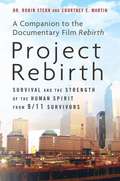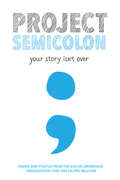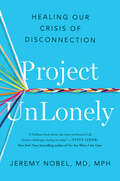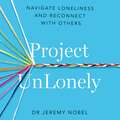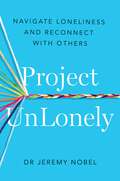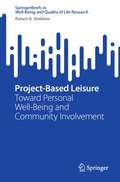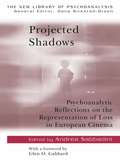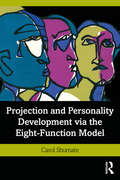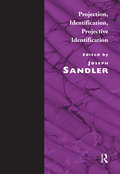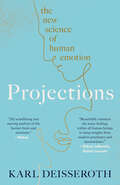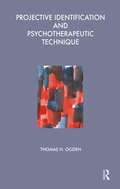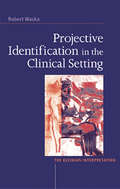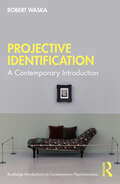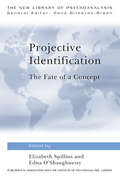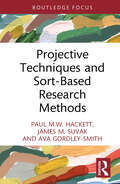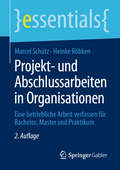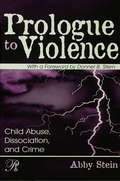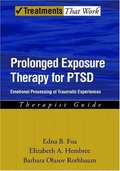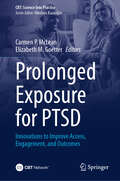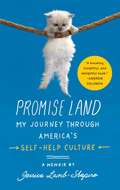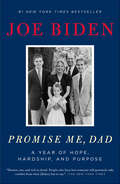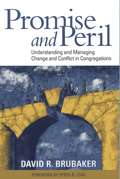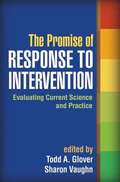- Table View
- List View
Project Rebirth: Survival and the Strength of the Human Spirit from 9/11 Survivors
by Courtney E. Martin Robin SternEach year, every year, on the anniversary of the attacks, Jim Whitaker and his film crew interviewed eight people who were directly affected by the events of 9/11. They used five of these subjects and their words as the basis for the documentary Rebirth, which premiered at the Sundance Film Festival in 2011. Based on the film, the book Project Rebirth allows the powerful rediscovery stories of all these individuals - both those featured in the film and those whose stories did not make it onto celluloid - to be shared with the world. Book jacket.
Project Semicolon: Your Story Isn't Over
by Amy BleuelFor fans of PostSecret, Humans of New York, and If You Feel Too Much, this collection from suicide-awareness organization Project Semicolon features stories and photos from those struggling with mental illness. Project Semicolon began in 2013 to spread a message of hope: No one struggling with a mental illness is alone; you, too, can survive and live a life filled with joy and love. In support of the project and its message, thousands of people all over the world have gotten semicolon tattoos and shared photos of them, often alongside stories of hardship, growth, and rebirth.Project Semicolon: Your Story Isn't Over reveals dozens of new portraits and stories from people of all ages talking about what they have endured and what they want for their futures. This represents a new step in the movement and a new awareness around those who struggle with mental illness and those who support them. At once heartfelt, unflinchingly honest, and eternally hopeful, this collection tells a story of choice: every day you choose to live and let your story continue on.Learn more about the project at www.projectsemicolon.com.
Project UnLonely: Healing Our Crisis of Disconnection
by Jeremy NobelInsight into our new world of loneliness that offers solace, hope, and solutions.Even before 2020, chronic loneliness was a private experience of profound anguish that had become a public health crisis. Since then it has reached new heights. Loneliness assumes many forms, from enduring physical isolation to feeling rejected because of difference, and it can have devastating consequences for our physical and mental health. As the founder of Project UnLonely, Jeremy Nobel unpacks our personal and national experiences of loneliness to discover its roots and to show how we can take steps to find comfort and connection. Dr. Nobel brings together many voices, from pioneering researchers, to leaders in business, education, the arts, and healthcare, to lonely people of every age, background, and circumstance. He discovers that the pandemic isolated us in ways that were not only physical, and that, at its core, a true sense of loneliness results from a disconnection to the self. He clarifies how meaningful reconnection can be nourished and sustained. And he reveals that an important component of the healing process is engaging in creativity, a powerful opportunity he shows us can be accessed by all. Supportive and clear-eyed, this is the book we will take into our new normal and rely on for years to come.
Project UnLonely: Navigate Loneliness and Reconnect with Others
by Jeremy NobelDr Jeremy Nobel offers practical solutions to the growing crisis of loneliness.Chronic loneliness is a private experience of profound anguish. It has also become a public health crisis. The Unlonely Project will not just sound an alarm about the significant, growing negative impact of loneliness on nearly every sector of society, but also offer solace, hope and solutions.While we can't cure loneliness the way we can cure strep throat or even cancer, there are concrete, actionable and effective things we can do to manage it and keep it from becoming chronic. For an individual lonely listener, or for anyone who loves, serves, treats, or employs people vulnerable to loneliness in community, work or educational settings, this audiobook will clarify how meaningful reconnection between the self and others begins, and how it can be nourished and sustained.(P)2023 Penguin Audio
Project UnLonely: Navigate Loneliness and Reconnect with Others
by Jeremy NobelEven before 2020, chronic loneliness was a private experience of profound anguish that had become a public health crisis. Since then it has reached new heights. While we can't cure loneliness the way we can cure strep throat or even cancer, there are concrete, actionable and effective things we can do to manage it and keep it from becoming chronic. For an individual lonely reader, or for anyone who loves, serves, treats, or employs people vulnerable to loneliness in community, work or educational settings, this book will clarify how meaningful reconnection between the self and others begins, and how it can be nourished and sustained.Loneliness assumes many forms, from enduring physical isolation to feeling rejected because of difference, and it can have devastating consequences for our physical and mental health. As the founder of Project UnLonely, Dr. Jeremy Nobel unpacks our personal and national experiences of loneliness to discover its roots and to show how we can take steps to find comfort and connection. Dr. Nobel brings together many voices, from pioneering researchers, to leaders in business, education, the arts, and healthcare, to lonely people of every age, background, and circumstance. He discovers that the pandemic isolated us in ways that were not only physical, and that, at its core, a true sense of loneliness results from a disconnection to the self. He clarifies how meaningful reconnection can be nourished and sustained. And he reveals that an important component of the healing process is engaging in creativity, a powerful opportunity he shows us can be accessed by all. Project UnLonely will not just sound an alarm about the significant, growing negative impact of loneliness on nearly every sector of society, but also offer solace, hope and solutions. Supportive and clear-eyed, this is the book we will take into our new normal and rely on for years to come.
Project-Based Leisure: Toward Personal Well-Being and Community Involvement (SpringerBriefs in Well-Being and Quality of Life Research)
by Robert A. StebbinsThis short book discusses the relatively new concept of project-based leisure in leisure research, and relates it to individual and community well-being and quality of life. The book defines PBL as a short-term, reasonably complicated, one-off or occasional, though infrequent, creative undertaking carried out in free time, or time free of disagreeable obligation. Such leisure requires considerable planning, effort, and sometimes skill or knowledge. The book discusses how PBL contributes to subjective well-being, though doing so more modestly than serious leisure and occupational devotion. The book surveys existing field research of the author’s own and other studies, and provides original insights on how PBL activities can be used to generate community involvement and subjective well-being.
Projected Shadows: Psychoanalytic Reflections on the Representation of Loss in European Cinema (The New Library of Psychoanalysis)
by Andrea SabbadiniProjected Shadows presents a new collection of essays exploring films from a psychoanalytic perspective, focusing specifically on the representation of loss in European cinema. This theme is discussed in its many aspects, including: loss of hope and innocence, of youth, of consciousness, of freedom and loss through death. Many other themes familiar to psychoanalytic discourse are explored in the process, such as: Establishment and resolution of Oedipal conflicts Representation of pathological characters on the screen Use of unconscious defence mechanisms The interplay of dreams, reality and fantasy Projected Shadows aims to deepen the ongoing constructive dialogue between psychoanalysis and film. Andrea Sabbadini has assembled a remarkable number of internationally renowned contributors, both academic film scholars and psychoanalysts from a variety of cultural backgrounds, who use an array of contemporary methodologies to apply psychoanalytic thinking to film. This original collection will appeal to anyone passionate about film, as well as professionals, academics and students interested in the relationship between psychoanalysis and the arts.
Projection and Personality Development via the Eight-Function Model
by Carol ShumateJung considered personality development critical for the survival of the human race, not just for personal fulfillment, but how can personality be developed? Carol Shumate shows how John Beebe’s revolutionary eight-function/eight-archetype model of personality type can be applied to guide development for each of the sixteen Myers-Briggs types, making explicit the implications of Jung’s eight-function model. Based on reports from participants at Beebe’s workshops and using examples of historic figures like Abraham Lincoln, this is the first book to detail how the unconscious aspects of the functions tend to manifest for each type. Projection and Personality Development via the Eight-Function Model can assist readers in realizing the transformation that Jung himself experienced. It will be key reading for Jungian analysts and psychotherapists, academics and scholars of Jungian and post-Jungian studies, and practitioners of psychological type.
Projection, Identification, Projective Identification
by Joseph SandlerThis book focuses on all aspects of projection and identification, and addresses the problems and perplexities of projective identification. It is based on the First Conference of the Sigmund Freud Center of the Hebrew University of Jerusalem.
Projections: A Story of Human Emotions
by Karl DeisserothA groundbreaking tour of the human mind that illuminates the biological nature of our inner worlds and emotions, through gripping, moving—and, at times, harrowing—clinical stories&“Poetic, mind-stretching, and through it all, deeply human.&”—Daniel Levitin, New York Times bestselling author of The Organized MindKarl Deisseroth has spent his life pursuing truths about the human mind, both as a renowned clinical psychiatrist and as a researcher creating and developing the revolutionary field of optogenetics, which uses light to help decipher the brain&’s workings. In Projections, he combines his knowledge of the brain&’s inner circuitry with a deep empathy for his patients to examine what mental illness reveals about the human mind and the origin of human feelings—how the broken can illuminate the unbroken.Through cutting-edge research and gripping case studies from Deisseroth&’s own patients, Projections tells a larger story about the material origins of human emotion, bridging the gap between the ancient circuits of our brain and the poignant moments of suffering in our daily lives. The stories of Deisseroth&’s patients are rich with humanity and shine an unprecedented light on the self—and the ways in which it can break down. A young woman with an eating disorder reveals how the mind can rebel against the brain&’s most primitive drives of hunger and thirst; an older man, smothered into silence by depression and dementia, shows how humans evolved to feel not only joy but also its absence; and a lonely Uighur woman far from her homeland teaches both the importance—and challenges—of deep social bonds.Illuminating, literary, and essential, Projections is a revelatory, immensely powerful work. It transforms our understanding not only of the brain but of ourselves as social beings—giving vivid illustrations through science and resonant human stories of our yearning for connection and meaning.
Projective Identification and Psychotherapeutic Technique
by Thomas OgdenThis book examines the projective identification and its clinical uses from a Kleinian perspective. It applies the perspective of projective identification to various aspects of the psychotherapy of borderline and schizophrenic patients.
Projective Identification in the Clinical Setting: A Kleinian Interpretation
by Robert WaskaHow do Kleinians work with projective identification?The concept of projective identification, first introduced by Melanie Klein in 1946, has been widely studied by psychoanalysts of different persuasions. However, these explorations have neglected to show what Kleinians actually do with the projective identification phenomenon in their daily casework. Projective Identification in the Clinical Setting presents a detailed study of Kleinian literature, setting a background of understanding for the day-to-day analytic atmosphere in which projective identification takes place. Extensive clinical material illustrates issues clearly identified for clinical practice, including:* the ways projective identification occurs within various psychological constellations;* the role of the analyst in countertransference experiences;* work with difficult patients who experience life within a paranoid or psychotic framework;* the path of projective identification and pathological greed. This comprehensive account of Kleinian literature on projective identification and wealth of clinical material provide a powerful and clear account of clinical practice around projective identification that all practitioners, psychoanalytic psychotherapists and trainees will benefit from reading. Robert Waska has worked in the field of psychology for the last twenty-five years. Certified as a psychoanalyst and psychoanalytic psychotherapist from the Institute of Psychoanalytic Studies, Dr Waska maintains a full-time private practice in San Francisco and Marin County.
Projective Identification: A Contemporary Introduction (Routledge Introductions to Contemporary Psychoanalysis)
by Robert WaskaThis clear and thoughtful book by Robert Waska provides an accessible introduction to Projective Identification and the role it plays in internal and external life. Waska explores how Projective Identification is the foundation for much of psychic life, driving internal phantasy, influencing interpersonal behavior, and contributing to the transference/countertransference environment. This book contains several case studies which explore and expand on the concepts described and which demonstrate how a psychotherapist can understand, contain, and interpret the states patients seek help with. Additionally, this book introduces a clinical technique which is intended to tame the underlying emotional conflicts. Part of the popular Routledge Introductions to Contemporary Psychoanalysis series, this book will be essential to students of psychoanalysis, as well as academics and practitioners familiarising themselves with Projective Identification in a clinical setting.
Projective Identification: The Fate of a Concept (The New Library of Psychoanalysis)
by Elizabeth Spillius Edna O’ShaughnessyIn this book Elizabeth Spillius and Edna O'Shaughnessy explore the development of the concept of projective identification, which had important antecedents in the work of Freud and others, but was given a specific name and definition by Melanie Klein. They describe Klein's published and unpublished views on the topic, and then consider the way the concept has been variously described, evolved, accepted, rejected and modified by analysts of different schools of thought and in various locations – Britain, Western Europe, North America and Latin America. The authors believe that this unusually widespread interest in a particular concept and its varied ‘fate’ has occurred not only because of beliefs about its clinical usefulness in the psychoanalytic setting but also because projective identification is a universal aspect of human interaction and communication. Projective Identification: The Fate of a Concept will appeal to any psychoanalyst or psychotherapist who uses the ideas of transference and counter-transference, as well as to academics wanting further insight into the evolution of this concept as it moves between different cultures and countries.
Projective Techniques and Sort-Based Research Methods
by Paul M.W. Hackett James M. Suvak Ava Gordley-SmithProjective Techniques and Sort-Based Research Methods offers a brief introductory guide to the use of these exciting, innovative and often artistic approaches, to students and researchers who have no prior knowledge of these. This book brings together a wide range of examples of projective and mapping techniques that offer the ideal methodology for researchers wishing to collect less controlled and filtered material, that tap the deeper levels of the conscious and sub-conscious to reveal a more profound, richer and hidden level of response. It presents the techniques in a way that will enable the reader to appreciate their nature and to choose an appropriate method for their own research. Information is also provided that allows readers to design and implement their own projective or sort-based approaches. Each of the approaches the authors present are concisely described, and their usages explained, along with references and examples of the applied usage of the technique. The book is valuable reading for researchers from a wide range of academic disciplines from within the social sciences, humanities, business studies, marketing, etc. The book is an introductory guide, but it will be appropriate for use with undergraduate, post-graduate and research students. It will also be of great use to professionals working in the areas of consumer behaviour, marketing and communications.
Projekt- und Abschlussarbeiten in Organisationen: Eine betriebliche Arbeit verfassen für Bachelor, Master und Praktikum (essentials)
by Marcel Schütz Heinke RöbkenMarcel Schütz und Heinke Röbken zeigen die Besonderheiten einer Projekt- oder Abschlussarbeit mit einem organisatorischen Bezug in einem Unternehmen, einem Verband, einer sozialen Einrichtung oder einer Behörde auf. Dieser Leitfaden kann von Studierenden diverser Studiengänge und aller Hochschultypen genutzt werden und eignet sich gleichermaßen sowohl für Absolventen grundständiger als auch dualer und weiterbildender Studiengänge. Ein Schwerpunkt liegt auf den Sozial- und Wirtschaftswissenschaften. In dieser überarbeiteten zweiten Auflage wurden weitere nützliche Informationen zur Durchführung aufgenommen, die Form der Darstellung optimiert und verschiedene Daten aktualisiert. Autorin und Autor betreuen seit Jahren regelmäßig auch betrieblich orientierte Studienarbeiten.Die Autoren:Marcel Schütz ist Research Fellow Betriebswirtschaft an der Northern Business School Hamburg. Daneben unterrichtet er an der Universität Oldenburg und der Universität Bielefeld und hat Praxiserfahrung im Personalwesen. Dr. Heinke Röbken ist Professorin für Bildungsmanagement an der Universität Oldenburg. Daneben verantwortet sie das Lehrgebiet Empirische Forschungsmethoden in MBA- und aufbauenden Management-Studiengängen.
Prologue to Violence: Child Abuse, Dissociation, and Crime (Psychoanalysis in a New Key Book Series)
by Abby SteinDespite mounting references to the "transgenerational transmission of violence," we still lack a compelling understanding of the linkage between the interpersonal violence of early life and the criminal violence of adulthood. In Prologue to Violence, Abby Stein draws on the gripping narratives of 65 incarcerated subjects and extensive material from law enforcement files to remedy this lacuna in both the forensic and psychodynamic literature. In the process, she calls into question prevailing beliefs about criminal character and motivation. For Stein the early trauma to which adult criminals are subjected remains unformulated and, as such, unavailable for reflection. Contrary to common belief, these criminals, especially sex murderers, do not commit their crimes in a rational or fully conscious way. They are not driven by deviant fantasy, their psychopathy is not inborn, and they rarely commit acts of violence "without conscience." Stein’s interdisciplinary analysis of her data infuses contemporary relational psychoanalysis with the insights of neuroscience, traumatology, criminology, and cognitive and narrative psychology. A powerful challenge to offender treatment programs to address the shaping impact of childhood trauma rather than merely to "correct" the cognitions of violent offenders, Prologue to Violence will be equally compelling to researchers and academics investigating child abuse and adult violence. Its mental health readership will be broad and deep, ranging beyond clinicians who work with offender populations to all therapists who wrestle with experiences of dissociation and aggressive enactment in everyday life.
Prolonged Exposure Therapy for PTSD
by Edna B. Foa Barbara Olasov Rothbaum Elizabeth A. HembreeAn estimated 70% of adults in the United States have experienced a traumatic event at least once in their lives. Though most recover on their own, up to 20% develop chronic Posttraumatic Stress Disorder. For these people, overcoming PTSD requires the help of a professional. This guide gives clinicians the information they need to treat clients who exhibit the symptoms of PTSD. It is based on the principles of Prolonged Exposure Therapy, the most scientifically-tested and proven treatment that has been used to effectively treat victims of all types of trauma. Whether your client is a veteran of combat, a victim of a physical or sexual assault, or a casualty of a motor vehicle accident, the techniques and strategies outlined in this book will help. In this treatment clients are exposed to imagery of their traumatic memories, as well as real-life situations related to the traumatic event in a step-by-step, controllable way. Through these exposures, your client will learn to confront the trauma and begin to think differently about it, leading to a marked decrease in levels of anxiety and other PTSD symptoms. Clients are provided education about PTSD and other common reactions to traumatic events. Breathing retraining is taught as a method for helping the client manage anxiety in daily life. Designed to be used in conjunction with the corresponding client workbook, this therapist guide includes all the tools necessary to effectively implement the prolonged exposure program including assessment measures, session outlines, case studies, sample dialogues, and homework assignments. This comprehensive resource is an exceptional treatment manual that is sure to help you help your clients reclaim their lives from PTSD. Treatments That Work TM represents the gold standard of behavioral healthcare interventions! All programs have been rigorously tested in clinical trials and are backed by years of research A prestigious scientific advisory board, led by series Editor-In-Chief David H. Barlow, reviews and evaluates each intervention to ensure that it meets the highest standard of evidence so you can be confident that you are using the most effective treatment available to date Our books are reliable and effective and make it easy for you to provide your clients with the best care available Our corresponding workbooks contain psycho educational information, forms and worksheets, and homework assignments to keep clients engaged and motivated A companion website (www.oup.com/us/ttw) offers downloadable clinical tools and helpful resources Continuing Education (CE) Credits are now available on select titles in collaboration with Psycho Educational Resources, Inc. (PER)
Prolonged Exposure for PTSD: Innovations to Improve Access, Engagement, and Outcomes (CBT: Science Into Practice)
by Carmen P. McLean Elizabeth M. GoetterThis book aims to reconcile a disconnect in the field of trauma psychology: On one hand, decades of accumulated evidence support the safety and efficacy of prolonged exposure therapy (PE) for posttraumatic stress disorder (PTSD). On the other hand, many individuals suffering from PTSD cannot access PE. Even among individuals who begin PE, many experience challenges in completing a full course of treatment. Further, PTSD is a complex and heterogenous disorder; not all individuals who complete PE experience a meaningful benefit. PE is an evidence-based psychological treatment that helps individuals approach situations and memories related to their trauma so that they learn to think differently about the trauma and no longer experience intense distress when confronted with trauma reminders. This book is designed for clinicians and researchers who share the goal of increasing the reach and impact of evidence-based treatment for individuals with PTSD. Each chapter synthesizes the latest research findings and provides clear clinical guidance to inform adaptations to improve access, engagement, and clinical outcomes for PE. Obtaining the best outcomes with prolonged exposure requires not only trained and skilled clinicians—it requires clinicians who have the ability to adapt, enhance, and tailor it for individual patients and settings. This should be a required textbook for all students and trainees in the area of psychological trauma. Alan L. Peterson, PhD, ABPP The first book of this type, the authors have provided valuable new information and summarized succinctly the academic literature that is the underpinning of the success of this approach to psychological care. It is both a comprehensive and essential book for all those interested in treating and studying trauma survivors. Terry Keane, PhD This book is… timely, including telemental health, intensive delivery formats, digital interventions, and virtual reality. Clinicians and researchers will find it invaluable. Barbara Olasov Rothbaum, PhD, ABPP
Promesas incumplidas: Las fuentes históricas de la indignación
by Javier MoscosoPromesas incumplidas es una historia sobre la ambición, ligada a la promesa igualitaria y al desengaño que marcó el Romanticismo. De la mano de Javier Moscoso, uno de los mejores ensayistas españoles contemporáneos. Ambición, resentimiento, envidia, celos... El Promesas incumplidas explora las emociones más estrechamente relacionadas con la rivalidad, pero también la fraternidad, el patriotismo, la compasión o la amistad. Las fuentes consultadas incluyen tratados de medicina, de filosofía moral y política, así como de lo que hoy denominamos psiquiatría. Junto a estos se han consultado textos biográficos y autobiográficos, así como material iconográfico, fuentes publicadas y manuscritas.
Promise Land
by Jessica Lamb-Shapiro"In writing this book I walked on hot coals, met a man making a weight-loss robot, joined a Healing Circle, and faced my debilitating fear of flying. Of all of these things, talking to my father about my mother's death was by far the hardest." The daughter of a widowed child psychologist and parenting author, Jessica Lamb-Shapiro grew up immersed in the culture of self-help, of books and pamphlets and board games and gadgets and endless jargon-filled conversations about feelings. It wasn't until she hit her thirties that Jessica began to wonder: if all this self-improvement arcana was as helpful as it promised to be, why wasn't she better adjusted? She had a flying phobia, hadn't settled down, and didn't like to talk about her feelings. Thus began Jessica's fascination with the eccentric and labyrinthine world of self-help. She read hundreds of books and articles, attended dating seminars, walked on hot coals, and attempted to conquer her fear of flying. But even as she made light of the sometimes dubious effectiveness of these as-seen-on-TV treatments, she slowly began to realize she was circling a much larger problem: her mother's death when she was a toddler, and the almost complete silence that she and her father had always observed on the subject. In the tradition of Augusten Burroughs, Jessica Lamb-Shapiro illuminates the peculiar neuroses and inalterable truths that bind families together, whether they choose to confront them or not. Promise Land is a tender, witty, and wise account of a young woman's journey through her own psyche toward the most difficult stage of grown-up emotional life: acceptance.
Promise Me, Dad: A Year of Hope, Hardship, and Purpose
by Joe BidenThe instant #1 New York Times bestseller: From President Joe Biden, a deeply moving memoir about the year that would change both a family and a country.In November 2014, thirteen members of the Biden family gathered on Nantucket for Thanksgiving, a tradition they had been celebrating for the past forty years. But this year felt different from all those that had come before. Joe and Jill Biden’s eldest son, Beau, had been diagnosed with a malignant brain tumor fifteen months earlier, and his survival was uncertain. “Promise me, Dad,” Beau had told his father. “Give me your word that no matter what happens, you’re going to be all right.” Joe Biden gave him his word.Promise Me, Dad chronicles the year that followed, which would be the most momentous and challenging in Joe Biden’s extraordinary life and career. As vice president, Biden traveled more than a hundred thousand miles that year, across the world, dealing with crises in Ukraine, Central America, and Iraq. When a call came from New York, or Capitol Hill, or Kyiv, or Baghdad—“Joe, I need your help”—he responded. For twelve months, while Beau fought for and then lost his life, the vice president balanced the twin imperatives of living up to his responsibilities to his country and his responsibilities to his family. And never far away was the insistent and urgent question of whether he should seek the presidency in 2016.Writing with poignancy and immediacy, Promise Me, Dad is a story of how family and friendships sustain us and how hope, purpose, and action can guide us through the pain of personal loss into the light of a new future.
Promise and Peril: Understanding and Managing Change and Conflict in Congregations
by David BrubakerCongregations cannot exist without finances, priorities, leadership, worship, and decision making, yet these five aspects breed the most conflict between church members and clergy. These conflicts unfortunately tend to bring about the most negative consequences: drops in giving, resignation of leaders, and, perhaps most pointedly, loss of members. The importance of congregations and their effect on our lives is clear, yet what is less clear is what makes conflicts in faith communities inevitable.
Promise of Response to Intervention
by Sharon Vaughn Todd GloverAs response to intervention (RTI) is adopted by increasing numbers of schools and districts, knowledge about "what works" continues to grow. This much-needed book analyzes the key components of RTI service delivery and identifies the characteristics of successful implementation. Critically reviewing the available research, leading authorities describe best practices in multi-tier intervention, assessment, and data-based decision making. Clear-cut recommendations are provided for implementing evidence-based interventions to support students' needs in reading, writing, math, and behavior. A state-of-the-art resource for K 12 practitioners and administrators, the book also will fill a unique niche in graduate-level courses.
Promises, Oaths, and Vows: On the Psychology of Promising
by Herbert J. SchlesingerConsidering that getting along in civil society is based on the expectation that (most) people will do what they say they will do, i.e., essentially live up to their explicit or implicit promises, it is amazing that so little scientific attention has been given to the act of promising. A great deal of research has been done on the moral development of children, for example, but not on the child’s ability to make and keep a promise, one of the highest moral achievements. What makes it possible developmentally, cognitively, and emotionally to make a promise in the first place? And on the other hand, what compels one to keep a promise (or vow or threat) when there seems to be no personal advantage in doing so, and even when harm can be predicted? How do we know when a promise is offered seriously to be taken at face value, and how do we understand that another is only a polite gesture, not to be taken seriously? In Promises, Oaths, and Vows: On the Psychology of Promising, Herbert Schlesinger addresses these questions, drawing on the literature of moral development in children; the psychotherapy of a patient who regularly broke promises that were unnecessary in the first place; those who were regarded as "promising youngsters" who did not fulfill their "promise"; and those who feared making a promise, a commitment, or a threat out of fear that, once made, the utterance would take on a life of its own and could never be taken back. Furthermore, he illustrates his conclusions by examining the widespread use of promising in classical literature, such as Greek drama and the plays of Shakespeare, as well as the motivating and reifying power of the promise in Western religious traditions. With a style honed over the penning of two previous books, Schlesinger once again produces a work grounded in a firm analytic sensibility, but which also retains the wit and candor of the seasoned analyst. His seminal investigation of this all but neglected topic in the clinical literature is as timely as it is scholarly, and – with the title firmly in mind – Promises, Oaths, and Vows is assured to be a worthy addition to any clinician’s library and a provoking investigation into Nietzsche’s notion of man as "the animal who makes promises."
